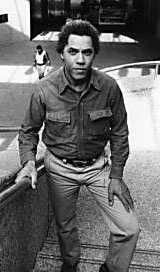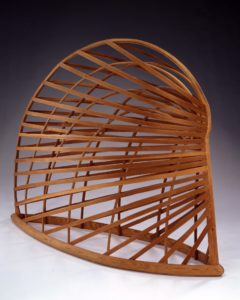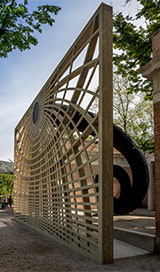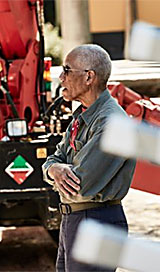Martin Puryear will represent the U.S. at the Venice Biennale (Sierra Leone)
Thanks for the ‘heads up’ from Gerry Schwinn (Nigeria 1963-65)
On the eve of the Venice Biennale, the artist’s shaping hand frames a view of his troubled, and troubling, homeland.

Martin Puryear’s “Swallowed Sun (Monstrance and Volute),” at the United States Pavilion of the Venice Biennale, which opens May 11. A perforated wood screen stretches across the forecourt, like a church rood screen. The pattern traces a perspectival view of dome and oculus. Credit: Martin Puryear, Matthew Marks Gallery and Madison Square Park Conservancy; Joshua White.
Martin Puryear, Citizen Sculptor
By Holland Cotter
May 3, 2019
New York Times
“This moment has caught me being as much a citizen as an artist,” said the sculptor Martin Puryear (Sierra Leone 1964-66) on an afternoon in his studio in New York’s Hudson River Valley early in April. In two days he would leave for Venice to begin installing a solo exhibition at the 58th Venice Biennale in which he will officially represent the United States. Rising to that responsibility can’t be easy in an American “moment” tense with divisive politics, resurgent racism, and gun violence. Yet anyone who has followed this artist’s 50-year career, knows he is more than up to the task.
Now 77, he is widely regarded as one of the nation’s most distinguished sculptors, though one who eludes foursquare categories, including “political artist.” His work, with its large forms, often of hand-planed and carpentered wood, looks abstract, though it is filled with references to things and events in the world. And though it refuses to yield ready meanings, it suggests many — cultural, emotional and political.
“Ensor, Bruegel, Goya,” the tall, soft-spoken artist said. “These are people who looked very candidly at the world they lived in. I hope that that’s what I’m trying to do.”
With two exceptions, one architectural in scale, the eight sculptures in his show at the United States Pavilion — “Martin Puryear: Liberty/Libertà,” organized by Brooke Kamin Rapaport, deputy director and senior curator of the Madison Square Park Conservancyin New York — were already underway in his studio before the Biennale invitation came. Taken together, they constitute a kind of précis of his styles and methods. But they’re also evidence of an intensified response to topical concerns in the present.

The sculptor in Chicago in 1984. He began teaching art in 1978 at the University of Illinois, a post he would keep for nearly a decade. Credit: Steve Kagan for The New York Times
Mr. Puryear was born in 1941 and grew up, African-American, in a racially segregated Washington, D.C. His father was a postal worker, his mother an elementary schoolteacher. He was an early reader and, I suspect, an avid, pre-internet surfer-gatherer of information. In fact, he still is, which is why it’s a mistake to try to pin his work down to any one set of sources and influences.
His parents took him to museums when he was very young — the National Gallery of Art, the Phillips Collection, the Smithsonian National Museum of Natural History — and for him the line between art, ethnology and science seems to have been loose: Paul Klee, Eskimo kayaks, and ornithological specimens all existed on a spectrum.
Also, he was raised Roman Catholic, and just by being in churches he may have absorbed, at an early point, a sense of the drama generated by mysteriously coded images and hidden interiors. “Confessional,” “Tabernacle” and “Reliquary” are titles he would later give to sculptures.
After graduating from the Catholic University of America in Washington in 1963, where he had majored first in biology and then in art, he joined the Peace Corps and was sent to Africa. There he taught science and languages in Sierra Leone, and studied with local potters, weavers and woodcarvers.

The work “Bower,” 1980, from slats of spruce and pine, has the grace of a loose-weave basket that seems to have been turned upside down — to become a trap. Credit: Martin Puryear, via Smithsonian American Art Museum
The work “Bower,” 1980, from slats of spruce and pine, has the grace of a loose-weave basket that seems to have been turned upside down — to become a trap. Credit: Martin Puryear, via Smithsonian American Art Museum
He has often commented on the impact of that two-year stay. As he told the art historian Richard J. Powell: “For most black Americans the connection to the Old Country is blank, erased by the middle passage of the slave trade. So to be able to live in West Africa and experience a tribal culture firsthand was priceless.” Invaluable too was the exposure to living art and crafts tradition, most visible in the production of traditional utilitarian objects.
Existentially, the African stay instilled in him a strong and abiding identity as a world citizen, living here or there, but belonging everywhere. Creatively, it introduced him to the idea that, when it came to the application of technology to art, less could be more; the hand was still the sovereign tool. Politically, it gave him an eye-opening perspective on his own troubled and troubling homeland.
Unready to return to America, he applied to European schools and enrolled in a printmaking program at the Royal Swedish Academy of Arts in Stockholm, where he lived for two years. An encounter there with the Siberian-born master furniture maker James Krenov clinched a commitment to sculpture, which led him, in 1969, to Yale University’s School of Art and Architecture as a graduate student.
The place was an odd fit. The kind of sculpture he was interested in — handmade from natural materials — was out of sync with a department dominated by Minimalism, which favored industrial fabrication, and by Conceptualism, which played down objects in favor of words and ideas. Mr. Puryear has described his outsider status there along class lines: the hands-off Minimalists and Conceptualists were “white collar;” he, with his saws and gouges and planes, was “blue collar.” Yet the divide was not absolute.
His work shares — or at least doesn’t reject — Minimalism’s faith in the expressive force of plain, solid forms, though in his case solidity is often an illusion. One of his best-known early works, “Self” from 1978, appears to be a simple, smoothed-down lump of solid, ebony-black matter, though it is actually a hollow shell painstakingly shaped from layered strips of wood.
At the same time, from privileging matter and form alone, his sculptures are prickly with ideas, some in the form of perturbing conceptual ambushes. A 1980 piece titled “Bower,” constructed from slats of spruce and pine, has the grace of a loose-weave basket, though this basket seems to have been turned upside down to become a trap.
And words, in the form of titles, have always been dynamic elements in his art, a way to bring complex narrative content to it, as in another 1980 piece, “For Beckwourth.”
The reference is to James Beckwourth, an early-19th-century American adventurer and fur trader who was born a slave, lived with Crow Indians, and worked for the United States Army. Over an adventurous lifetime, he managed to transcend the constraints built into a unitary racial identity. Yet he cannot be counted a hero — he assisted the army in massacring native peoples to clear the way for white settlers — and in Mr. Puryear’s dark, floor-hugging, mound of earth and wood he isn’t one.
“I’m not in an ivory tower making my work,” he said in April. “The ivory tower has been invaded.”
“For Beckwourth” is the work of an artist who counts himself deeply American — “I think I’m a patriot,” he said, with doubt in his voice — but an American who has serious doubts about what, ethically, American means, particularly now. And that’s the artist we meet in the pieces that he’s sent to the Biennale, two of them custom-made for the occasion.
One, “Swallowed Sun (Monstrance and Volute),” is immense. Designed by Mr. Puryear in collaboration with Tod Williams Billie Tsien Architects, it’s in two parts, the most immediately visible: a high, white perforated wood mesh that stretches across the Pavilion’s forecourt, like a church rood screen, half-obscuring what’s beyond it. Churchlike, too, is the screen’s openwork pattern, which traces a flattened-out perspectival view of a dome with an open, circular oculus high up.
It’s a beautiful image, perfect for Roman Catholic Venice. And the United States Pavilion actually has such a dome, one based on a quasi-sacred source: the dome on Thomas Jefferson’s Monticello, outside Charlottesville, Va. That building was a model for the American architects who designed the Pavilion in 1930 as a neo-Classical chapel dedicated to art and global democracy.
 The work’s second component is quite different in character: a black, twisting tube, inspired by a detail on a Greek column but resembling, in shape and color, a lamprey or snake. With its “tail” end curled on the forecourt floor, the tube stretches upward and entirely covers the screen’s oculus with its “mouth.” Structurally, the tube is a source of support for the screen; symbolically, it’s devouring its light.
The work’s second component is quite different in character: a black, twisting tube, inspired by a detail on a Greek column but resembling, in shape and color, a lamprey or snake. With its “tail” end curled on the forecourt floor, the tube stretches upward and entirely covers the screen’s oculus with its “mouth.” Structurally, the tube is a source of support for the screen; symbolically, it’s devouring its light.

“New Voortrekker,” 2018. Credit: Martin Puryear, Matthew Marks Gallery and Madison Square Park Conservancy; Joshua White
The Voortrekkers were 19th-century Dutch-speaking Europeans who traveled in covered wagons to the interior of South Africa to escape British rule. Their “Great Trek” became a founding myth as they fought and displaced South Africa’s indigenous people. Mr. Puryear updates his piece with a truck and associates the circle-the-wagon Voortrekker mentality with white national survivalists today.

“Tabernacle,” 2019. Credit: Martin Puryear, Matthew Marks Gallery and Madison Square Park Conservancy; Ron Amstutz
“Tabernacle,” 2019. Mr. Puryear, raised Roman Catholic, may have absorbed a sense of the drama generated by coded images and hidden interiors. The work, in the form of a military cap worn by Union and Confederate soldiers, hides a cannon ball ready for firing. The viewer is reflected in it, a combatant in a political present.

Like a raised fist, “A Column for Sally Hemings” stands within the United States Pavilion beneath its Jeffersonian dome. It is an abstract tribute to the African-American slave owned by Thomas Jefferson and the mother of five children by him. The fluted Classical column is stabbed at the top by an iron stake from which a shackle hangs. Credit: Martin Puryear, Matthew Marks Gallery and Madison Square Park Conservancy; Joshua White
The battle between darkness and light continues inside with the show’s other site-specific work, “A Column for Sally Hemings,” conceived to stand, linchpin-like, at the Pavilion’s precise center, directly beneath the Jeffersonian dome. Sally Hemings was an African-American slave owned by Jefferson and the mother of five children by him. She and her story were probably unknown to the Pavilion’s builders, so Mr. Puryear introduces her, strikingly and abstractly, in a monument to her. It’s composed of a single white, fluted Classical column that seems to be melting and is stabbed through the top by an upright iron stake from which a shackle hangs.
I wouldn’t call this a triumphant image. It’s a battle standard, defiant, like a raised fist. And the battle is on, no quarter, in a third piece, “Tabernacle,” the last to leave the studio for Venice. Dating from 2018, it’s in the form of a military cap, six feet high, of a kind worn by both Union and Confederate soldiers. With its striking bulk, it encourages us at first to linger over its surface. But there’s a secret inside. Look through a glass-covered hole cut in its crown and you find yourself staring, through cross hairs, at a siege mortar holding a cannon ball ready for firing. The ball is mirrored and you are reflected in it, a combatant, willing or not, in a political present that has sometimes been called a new American Civil War.
It’s a mistake to view Mr. Puryear’s art through any single lens, but the theme of “war” is certainly there to be found. “I don’t want to see this moment become normalized,” Mr. Puryear said. “We have to dig our way out of this somehow.” In Venice, with a citizen’s concern and an artist’s acute commitment, he’ll be digging deep.
Holland Cotter is the co-chief art critic. He writes on a wide range of art, old and new, and he has made extended trips to Africa and China. He was awarded the Pulitzer Prize for Criticism in 2009.

Wonderful news. He’s a breath-takingly brilliant artist!